Hybrid tomato "Berberana": advantages and disadvantages of the species, step-by-step method of growing it
Berberan's tomato is a young Dutch hybrid that has already conquered Russian vegetable growers. It is a high-yielding tomato, resistant to many dangerous diseases, well adapted to high temperatures, capable of taking root in any region. Trustworthy reviews and colorful photographs complement the positive characteristics of the culture.
We will study the features and characteristics of the hybrid, the rules for growing it in greenhouses.
The content of the article
Characteristics and description of tomato
Berberana - the development of Dutch breeders of an international company Enza zaden... This is not the first company culture to be appreciated by Russian tomato lovers. It intended for cultivation only in greenhouses: in amateur and industrial.
Distinctive features
The bush is indeterminate, spreading, 1.5-1.8 m high. The foliage is medium, the leaves are dark green.
An early ripe hybrid, from the moment of emergence to full maturation, it takes 95-100 days.
The yield is high, from 1 sq. m, 8-13 kg of fruits are harvested, provided that 3 seedlings are planted per 1 sq. m. Ovaries are formed in all weather conditions, even unfavorable ones.
The hybrid is well adapted to high temperatures, which is important if the crop is cultivated in greenhouse conditions.
Possesses increased resistance to many diseases of the Solanaceae family, such as tobacco mosaic, cladosporium, fusarium, bronze spot, verticillium wilting.
Reference. The genes of the hybrid have an immunity to diseases of viral and fungal etiology.
Culture needs a must pinching and tying up tall plants.
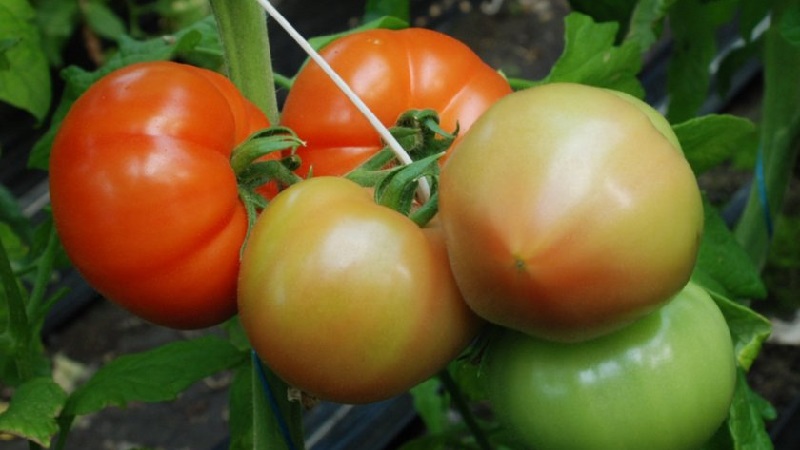
Fruit characteristics
The average weight of one fruit is 210-260 g. The shape is round, slightly flattened. The color is bright red, the taste is excellent, sweet with pleasant fruity notes, the pulp is juicy. The skin is dense, there are 4-6 seed chambers.
The purpose of ripe vegetables is universal. They are excellent for fresh consumption and do not lose their taste when processed in winter preparations.
Can be stored for 4 weeks without loss of appearance and taste. They withstand long-term transportation well.
The photo shows the Berberan F1 tomatoes.
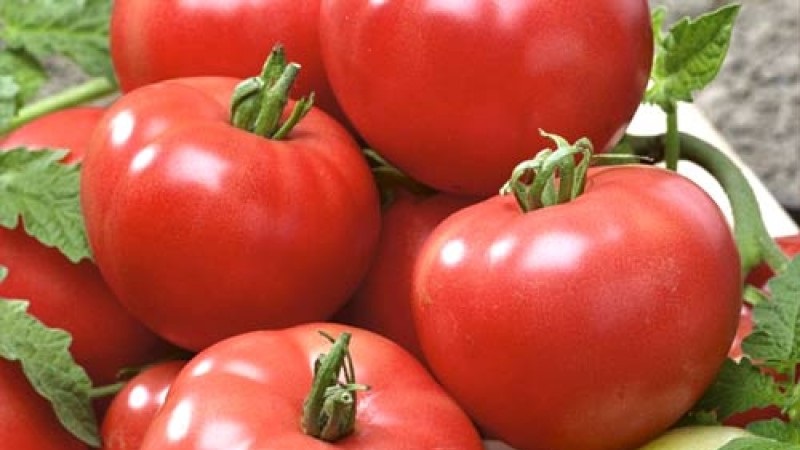
How to grow seedlings
Sowing seeds begins in late February or early March. The tomato belongs to hybrid, which means you need to prepare it yourself seed for landing will not work. You have to buy them every time.
Reference. Hybrids do not retain their parental properties in subsequent generations.
Seed preparation
As a rule, purchased planting material does not need disinfection. The manufacturer takes care of this himself. The only thing that does not hurt is to soak the grains in a growth stimulator to improve germination.
Reference. The most popular growth stimulants are Epin, Zircon and Kornevin.
To obtain the highest germination percentage, the seeds must be carefully examined for external defects: they must be light in color, without distortion or visible damage.
The grain is checked for emptiness by placing it in a saline solution. To do this, dissolve 1 teaspoon of salt in a glass of water and drop the seeds there.Those that floated to the surface are not suitable for sowing.
Capacity and soil
The soil mixture is made from garden soil, humus, and wood ash. All components are thoroughly mixed and spilled with a solution of pink potassium permanganate. This is how the prepared soil is disinfected.
The preferred option for sowing containers is peat pots. The seedlings of the hybrid are difficult and painful to tolerate the pick. After such a procedure, the sprouts do not grow for a long time. When grown in peat containers, the sprouts do not need a pick. In addition, when transplanting into the ground seedlings placed in holes along with peat pots, which dissolve in the ground without damaging the root system of young bushes.
Planting containers are half filled with soil, having previously placed some sawdust or small pebbles on the bottom as drainage... As the seedlings grow, the remaining soil is poured into the container. So young plants receive more nutrients.
Sowing seeds and caring for seedlings
The seeds are sown in individual containers in grooves 1.5 cm deep. After sowing, the ground is leveled from above, compacted and slightly moistened with warm, settled water (at least 22 ° C). Then the containers are covered with a thin film to create a greenhouse effect and left in a warm and well-lit room at a temperature of at least 23 ° C.
Reference. Throughout the growing season, from the moment of sowing seeds, the culture needs bright light.
Water the seedlings as the top layer of the soil dries up with warm, settled water with a tablespoon along the edge of the containers. After glaze the earth is shallowly loosened with a wooden stick or ordinary fork.
After the appearance of two true leaves, the seedlings are fed with liquid complex fertilizer. The first feeding is required to strengthen the immunity of the seedlings.
2 weeks before transplanting into the ground, the seedlings begin to harden. To do this, it is taken out into the open air initially for 20-40 minutes, gradually increasing the time spent outdoors up to several hours. During the hardening process, it is important to protect the seedlings from drafts, which are detrimental to tomatoes.
How to grow tomatoes
Seedlings are transplanted into protected ground in early or mid-May, focusing on the soil temperature, which should not be less than 15 ° C.
Landing
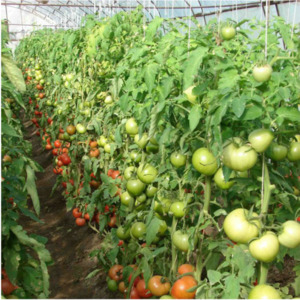 The soil is preliminarily loosened and mixed with humus. If tomatoes have previously grown in the greenhouse, it is better to replace and disinfect the top layer of soil. Such agricultural application increases the nutritional value of the soil and reduces the likelihood of contracting fungal infections.
The soil is preliminarily loosened and mixed with humus. If tomatoes have previously grown in the greenhouse, it is better to replace and disinfect the top layer of soil. Such agricultural application increases the nutritional value of the soil and reduces the likelihood of contracting fungal infections.
Young tomatoes are transplanted into holes 15 cm deep. Before planting, some wood ash is placed on the bottom of the hole.
Planting pattern: 50 cm - the distance between the seedlings, 55-60 cm is left between the rows. For 1 sq. m place 3-4 seedlings in a checkerboard pattern.
This method of planting allows young plants to receive the required amount of light and ventilate. Sprawling bushes require a lot of space for full growth and development.
After transplanting, the soil is compacted, moderately moistened, loosened and hilled. Transplanted bushes adapt to new conditions within a week.
Berberana tomato care
Tomatoes are watered regularly 2 times a week, otherwise the accumulation of excess moisture will have a detrimental effect on the root system. Watered in moderation, with extremely warm, settled water, strictly at the root. Water for irrigation is heated in barrels in the sun. The culture responds well to drip irrigation.
After each watering, the soil must be loosened, removing weeds with roots. To retain moisture, the beds are mulched. In addition, mulch protects the earth from pests from the insect world. Loosening the soil contributes to better oxygen penetration to the roots, which is necessary for the full development of plants.
Tomatoes are fed once every 2 weeks with liquid fertilizers based on potassium and phosphorus or organic matter.Mullein infusion is used as organic matter in a ratio of 1:10.
Features of cultivation and possible difficulties
Culture needs compulsory pinching. If you do not remove excess shoots, the plant will consume nutrients to develop unnecessary branches, and not to form ovaries.
The bushes are formed into 1 or 2 stems, it is with such indicators that the maximum amount of harvest is observed. With excessive growth, the top of the plant is pinched.
The variety belongs to carpal tomatoes, which are usually tied to trellises. Fruiting branches are fixed with soft ropes to avoid breaking them. Each brush forms a large number of fruits, the weight of which the branches cannot withstand without fixation.
Diseases and pests
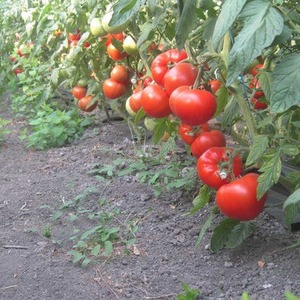 The hybrid is resistant to the main diseases of the Solanaceae family, so it is quite possible to do with the usual preventive measures: moderate watering with control of soil moisture, systematic loosening of the soil with the removal of weeds and regular ventilation of protected structures.
The hybrid is resistant to the main diseases of the Solanaceae family, so it is quite possible to do with the usual preventive measures: moderate watering with control of soil moisture, systematic loosening of the soil with the removal of weeds and regular ventilation of protected structures.
It is also possible to spray the plants with broths of onion husks, garlic and burdock. Such preventive measures not only prevent the spread of infections, but also protect the bushes from pest attacks. In the greenhouse, the spider mite is especially dangerous, since it loves greenhouse conditions, which are considered its habitat.
Mulching the beds with straw or fish heads buried in the ground and chopped cloves of garlic helps from the bear. Medvedka feels unpleasant odors from afar and tries to bypass them.
Treatment of the stem with soapy water helps from aphids. If there are a lot of aphids, the whole plant is sprayed. Also, the soap solution protects from the invasion of slugs.
Mustard bushes planted next to tomatoes are saved from the Colorado potato beetle. The beetle is dangerous because its larvae, which the females leave on the inside of the leaves, also feed on tomato crops. Therefore, when inspecting plants for the presence of pests, inspect the leaves on both sides.
The nuances of growing crops in different regions
Tomato is intended for cultivation in any greenhouse, regardless of their size and coverage. The culture develops well in glazed, polycarbonate, film greenhouses. It is completely unsuitable for open ground, even in the warmest regions.
In regions with a warm climate, the tomato is planted under film shelters; in cold areas, it is bred in glazed greenhouses with additional heating.
To exclude the development of fungal spores, the protected structures must be ventilated without creating drafts. A regular supply of fresh air destroys the pathogenic environment and makes the conditions in the greenhouse less favorable for insect pests.
Important. To mark the point of growth in tall plants, pinch the crown. In such cases, the plants consume nutrients for the formation of fruits, and not for further growth of the stem.
Harvesting and application of the crop
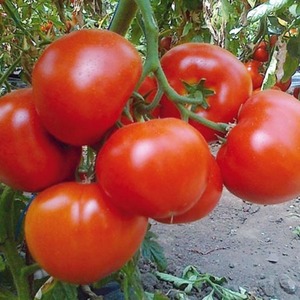 Depending on climatic conditions, fruit ripening in different regions is not the same. The average time is 95-100 days, but in cold areas they start harvesting a little later.
Depending on climatic conditions, fruit ripening in different regions is not the same. The average time is 95-100 days, but in cold areas they start harvesting a little later.
Maturation is amicable, with whole brushes, which greatly simplifies collection. It is not necessary to wait for the vegetables to fully ripen, they are quite capable of ripening on their own at room temperature.
The purpose of the fruit is universal. They look great in summer salads, perfectly complement any vegetable and meat dishes.
Do not lose their taste in pickles, marinades, preserves. They are used for processing into tomato products: juices, ketchups, adjika, pastes.
Ripe vegetables can be stored for 4 weeks without loss of flavor. They perfectly withstand long-term transportation, while maintaining their presentation.
Advantages and disadvantages
 Positive qualities of the Dutch tomato:
Positive qualities of the Dutch tomato:
- high resistance to diseases;
- high rate of fruiting;
- unpretentious care;
- excellent adaptation to high temperatures;
- excellent fruit taste;
- amicable maturation;
- versatility in cooking;
- long-term maturation;
- long transportation.
Some negative aspects:
- the possibility of breeding only in protected structures;
- garter required;
- pinching is required;
- impossibility of self-selection of seeds for the next planting.
Farmers reviews
 Gardeners leave positive feedback on the taste of ripe vegetables. With proper care, they grow sweet, juicy, with pleasant fruity notes. Often, fans of Dutch breeding breed two tomato hybrids on their plots - Mahitos and Berberana - to understand which is better. These hybrids are similar to each other in growing conditions and rates of fruiting. The main difference between Mahitos: in warm regions it is transplanted from greenhouses to open beds, and collecting a double crop.
Gardeners leave positive feedback on the taste of ripe vegetables. With proper care, they grow sweet, juicy, with pleasant fruity notes. Often, fans of Dutch breeding breed two tomato hybrids on their plots - Mahitos and Berberana - to understand which is better. These hybrids are similar to each other in growing conditions and rates of fruiting. The main difference between Mahitos: in warm regions it is transplanted from greenhouses to open beds, and collecting a double crop.
Gardeners' comments on Dutch culture:
Ekaterina, Kislovodsk: “I am planting two tomatoes at once, Mahitos and Berberana. The first is more capricious, it requires more light, but in general, caring for it is simple. Both types have excellent taste, excellent fruiting, vegetables are universal. I tie up, I feed my stepson. I breed both tomatoes only under a film cover. The Dutch varieties are the best. It's a pity, you have to buy seeds every time. It's good that the price is affordable. "
Stepan, Yaroslavl: “The yield is excellent. True, there were some minor difficulties in the process. The brushes were hanging down to the ground, so I had to put additional supports. Tomatoes were large, weighing up to 400 g. Very tasty and aromatic. Doesn't get sick and doesn't require much trouble. "
Conclusion
Dutch cultures have successfully taken root in Russian regions. They were appreciated and grown by summer residents with pleasure on their plots, despite some difficulties that arise during the growing season.
The Berberan hybrid is highly resistant to dangerous diseases, productive, unpretentious in care, capable of giving excellent fruits, suitable not only for fresh salads, but also for preparations for the winter.